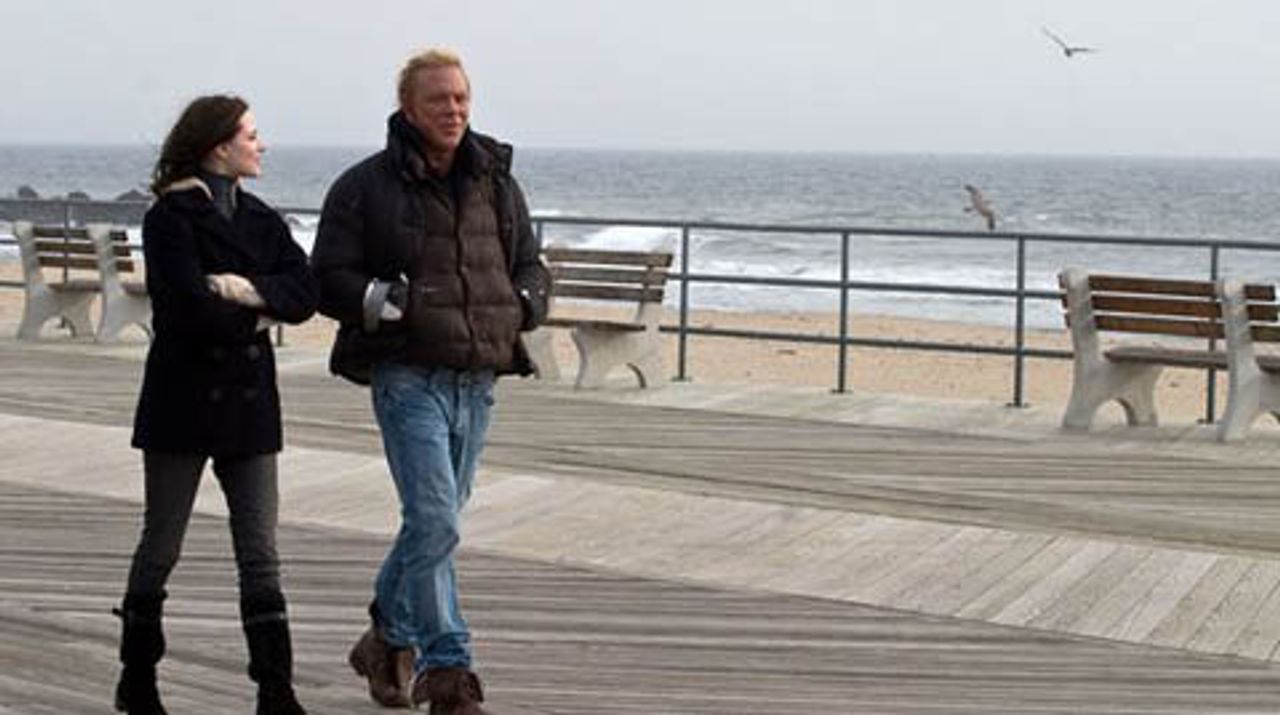Directed by Darren Aronofsky, written by Robert D. Siegel
In Darren Aronofsky's fourth feature film, The Wrestler, veteran actor Mickey Rourke plays Randy 'The Ram' Robinson, a professional wrestler in his fifties who is coping with life as a prisoner of his own mistakes. Twenty years after a career that spawned his likeness on posters and action figures and generated a video game franchise, Randy lives in a shabby trailer in a bleak New Jersey suburb. It is a lifestyle he can barely afford, and which he maintains by competing in violent amateur brawls with performers half his age.
 The Wrestler
The Wrestler
The partly choreographed matches—which demand crashing through glass and sustaining staple-gun wounds in front of a rabid audience—are a tremendous strain on a body mangled by painkillers, steroids, tanning salons and plastic surgery.
He seeks warmth with Cassidy (Marisa Tomei), a dancer he solicits for private performances in a local strip club. She refuses, at first, to see him as anything other than a client. After suffering a heart attack during a particularly vicious event, he retires 'The Ram,' and finds an emotionally challenging job behind a supermarket counter serving cold cuts.
It is in this environment that it dawns on Randy to pursue a meaningful relationship with his twenty-one-year-old daughter Stephanie (Evan Rachel Wood), whom he abandoned years ago in exchange for the spotlight. Randy's pattern of self-destruction, however, threatens that too. With little else to live for, 'The Ram' emerges one final time for a rematch against a longtime opponent.
In The Wrestler, Aronofsky considers with more restraint themes he explored in his aggressive, overwrought portrayal of heroin addiction, Requiem for a Dream (2000): the cult of celebrity; the exploitation of flesh; the circulation of commodities within the urban milieu. Randy is a self-described 'broken piece of meat.' He turns up in the hands of a child as a plastic toy, a two-dimensional caricature in a video game, and finally a living, breathing action figure in superhero tights on stage. Mirroring his position is Cassidy ('I'm not a stripper, I'm a mom!'), who undergoes humiliation to provide for her children.
Rourke's early life seems to parallel Robinson's, a fact that no doubt enriched his connection to the material. The future actor was born in 1956 in Schenectady, New York, the son of an amateur bodybuilder. At the age of 12 Rourke won his first boxing match, performing as 'Andre Rourke.' Like Robinson, he would be forced to retire after a series of debilitating injuries, and would later return to the ring on questionable terms. Rourke imbues Robinson with an idiosyncratic sensitivity that contradicts the brutality the character's professional life endorses. The performance is an honest one, and perhaps one of Rourke's best.
His acting career and his fate as a public figure, of course, also find echoes in the portrait of Robinson: considerable success, celebrity, apparently spectacular self-destruction and all the rest.
Aronofsky is consistently self-conscious in his aesthetic approach, using surging, combative visual techniques to represent thoughts and feelings; there is in The Wrestler what appears to be a fascination with violence as a mode of commentary. Oftentimes, this leaves one with a sense of being knocked down. One flinches or must look away from the onslaught, while the filmmaker employs the methods he claims to be critiquing.
By contrast, scenes with a similar narrative function in a film such as Benny's Video (1992, dir. Michael Haneke) are given an almost clinical distance that offers room for reflection while effectively 'getting the point across.' This is largely unavailable to us in Aronofsky's current intrusive style of presentation.
In the film's best moments, we are allowed enough time to gaze at a real human face. The scenes of Randy working behind the supermarket counter, cutting slices of meat for customers, have a sense of urgency and despair that take place within a palpable reality. At the moment of initial reconciliation between father and daughter, Aronofsky sets the scene against what appears to be the ruins of Brooklyn's former Coney Island. Randy and Stephanie reminisce on a chilly, desolate boardwalk, and share a dance in the remnants of a demolished structure. It hints at Randy's emotional devastation, and the impossibility of regaining what is lost. Moments like these show promise. But the framework is wanting.
Too much emphasis is put on Randy the individual to help identify a clear cause of his predicament. We are given popular generalizations floating just outside the narrative—celebrity, excess, alienation. These concepts, while to the point, are not given a human face, one that can be understood or dissected. Certainly, they are hinted at, but they remain in the frightening shadows. Dorothy never sees the Wizard.
Parallels are drawn within the film by other characters to Randy’s mythic status (Hercules and Jesus Christ are mentioned). Randy most resembles Sisyphus, the deceitful king condemned to roll a giant stone to the top of a mountain, where it rolls back down for eternity. The Wrestler purports, like a myth, to reveal something about the human condition. Randy assumes the figure of a mortal man who has made mistakes and is condemned to existential torment in the context of a world without hope. What then is the point of redemption?
One walks away from The Wrestler in a vivid malaise and with the wrong uncertainties. A sharper, clearer understanding of the processes involved in the manufacture of an 'icon' and an analysis of the factors that threaten to destroy him are missing. The Wrestler is vigorous, but opaque.
